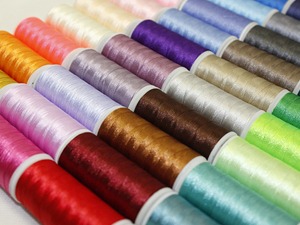Classification of yarn products
2021/5/23
![]()
1、 General classification of yarn products:
1. Different raw materials used: pure cotton yarn, purified fiber yarn, cotton blended yarn, wool blended yarn, etc.
2. The methods of spinning are different: ring spinning yarn, airflow spinning yarn, electrospinning yarn, etc.
3. The spinning process is different: ordinary combed yarn, combed yarn, waste spinning, new spinning, etc.
① Plain combed yarn: a ring spun yarn spun without a combing process, used for general needle and woven fabrics;
② Combed yarn: Using high-quality cotton fibers as raw materials, an additional combing process is added when spinning compared to plain combed yarn. The spun yarn has excellent quality and is used to weave high-quality fabrics, such as high-quality poplin and fine cloth;
③ Waste spun yarn: refers to the yarn made entirely from waste cotton processed during the spinning process, used for weaving low-grade cotton blankets, flannel, and blanket fabrics;
④ New spinning: It is a yarn spun using a new spinning system.
4. The different twisting directions are: smooth twisting (s twisting) and backhand twisting (z twisting).
① Backhand twist (also known as Z-twist) yarn is widely used in various fabrics;
② Shunshou Twist (also known as S Twist) yarn, used for weaving weft yarns in flannel fabrics.
5. Different product uses: warp, weft, knitting yarn, industrial yarn, etc.
① Warp yarn is a type of yarn in woven fabric that runs parallel to the edge of the fabric and has a high strength, usually with a high twist;
② Weft yarn is a yarn in the direction perpendicular to the selvage in woven fabrics, with lower strength requirements than warp yarn, and generally lower twist than warp yarn, maintaining a certain degree of softness;
③ Knitting yarn requires cleanliness, uniformity, and low twist to prevent breakage during weaving bending;
④ Industrial yarn such as tire cord, conveyor belt yarn, and healthcare yarn.
6. According to yarn dyeing and finishing and post-processing, it is divided into natural colored yarn, dyed yarn, colored spinning yarn, bleached yarn, mercerized yarn, singeing yarn, etc.
① Natural color yarn (also known as primary color yarn): maintains the fiber"s natural color and is used for weaving primary color grey fabrics;
② Dyed yarn: The colored yarn obtained by boiling and dyeing the primary color yarn is used for colored weaving;
③ Color spun yarn (including mixed color yarn): a yarn made by dyeing fibers first and then spinning them, which can be woven into a fabric with irregular dots and patterns in appearance;
④ Bleached yarn: made by refining and bleaching primary colored yarn, used for weaving bleached fabrics, and can also be interwoven with dyed yarn to form various colored woven products;
⑤ Mercerized yarn: Cotton yarn that has undergone mercerization treatment. There are mercerized bleached and mercerized dyed yarns for weaving high-quality dyed fabrics;
⑥ Singeing yarn: The surface fuzz of the yarn is burned off by a singeing machine to produce a yarn with a smooth surface for weaving high-quality products.
7. Structural characteristics are divided into: short fiber yarn, filament yarn, bulky yarn, fancy yarn (thread), composite yarn (thread), etc.
① The yarn composed of cotton, wool, and other fibers twisted back and wrapped together is called short fiber yarn, and its structure is complex and slightly different due to different spinning and twisting methods;
② Multiple strands of silk or synthetic fibers are combined, and a small amount of twist is added to form a long silk yarn;
③ The bulky yarn itself is a staple or filament yarn, but it has a larger expressive volume and is loose and soft compared to the original yarn;
④ Fancy yarn has a fancy appearance for decoration, with many varieties and production methods. The structure of fancy yarn consists of core yarn, decorative yarn, and fixed yarn;
⑤ Composite yarn (thread) has a uniform outer surface and is composed of yarns of different components.
Jieshou Shuangli Thread Industry Co., Ltd CN Copyright 皖ICP备19018814号-1 Disclaimer

